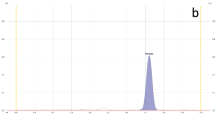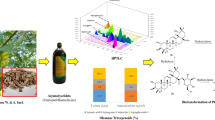Abstract
The bark of Terminalia arjuna (Combretaceae) is traditionally used for cardio-protective and cardio-strengthening properties worldwide. It is rich in glycosides, triterpenoids, flavonoids, tannins, sitosterol, and minerals, it is extensively used for its potent medicinal properties, and, in turn, it has been often adulterated with the barks of Terminalia alata, Terminalia bellirica, Terminalia calamansanai, Terminalia catappa, Terminalia chebula, Terminalia myriocarpa for commercial purposes. However, these adulterants and substitutes considerably differ in their phytochemical profile and medicinal properties, which further lead to the loss of major therapeutic effect of T. arjuna bark-based products. The main aim of the present research was to identify the presence of the major constituents arjunetin and arjungenin as marker compounds in representative plant bark and the detection of probable adulterants in the bark of T. arjuna powder. Investigation was carried out on stem bark powders from T. arjuna, T. bellirica, T. calamansanai, and T. chebula using the high-performance thin-layer chromatography (HPTLC) technique: the method exploited pre-coated silica gel TLC aluminum plates 60F254 on aluminum sheets (10 × 20 cm) as the stationary phase, while the mobile phase consisted of toluene‒ethyl acetate‒formic acid (5:4:1, V/V). Densitometric analysis of arjungenin and arjunetin was carried out in respective absorbance modes at 420 and 475 nm. The presence of arjungenin and arjunetin was confirmed by the ultraviolet (UV) exposure of all TLC patterns of samples compared with standards within RF 0.43 and 0.67, respectively. The regression mode for the calibration plots arjunetin and arjungenin showed good linear relationship (i.e., R2 = 0.9921, SD = 3.53% and R2 = 0.98687, SD = 13.77%, respectively), in the concentration range of 100–1000 ng/spot. Adulteration was assessed on the basis of detection of additional peaks and size variation of standard peaks in mixed extracts. The findings may be useful in the identification as well as quality evaluation technique for herbal drugs. However, major lacunae still lack phytochemical standardization of bark extracts to identify and clarify individual active principles/compounds with exact phytochemicals responsible for these curative effects of T. arjuna, T. bellirica, T. calamansanai and T. chebula. Thus, further investigations are required.




















Similar content being viewed by others
References
Attimarad M, Ahmed KM, Aldhubaib BE, Harsha S (2011) High-performance thin layer chromatography: a powerful analytical technique in pharmaceutical drug discovery. Pharm Methods 2:71–75
Arya D, Joshi GC, Tiwari LM (2012) Status and trade of crude drugs in Uttarakhand. J Med Plants Res 6:3434–3444
Amalraj A, Gopi S (2017) Medicinal properties of Terminalia arjuna (Roxb.) Wight & Arn.: a review. Tradit Complement Med 7:65–78
Chitlange SS, Kulkarni PS, Patil D, Patwardhan B, Nanda RK (2009) High-performance liquid chromatographic fingerprint for quality control of Terminalia arjuna containing Ayurvedic churna formulation. J AOAC Int 92:1016–1020
Dwivedi S, Gupta D (2002) Efficacy of Terminalia arjuna in chronic stable angina. Indian Heart J 54:441 (author reply 441)
Dwivedi S, Chopra D (2014) Revisiting Terminalia arjuna—an ancient cardiovascular drug. J Tradit Complement Med 4:224–231
Fahmy NM, Al-Sayed E, Singab AN (2015) Genus Terminalia: a phytochemical and biological review. Med Aromat Plants 4:5. https://doi.org/10.4172/2167-0412.1000218
Gaikwad D, Jadhav N (2018) A review on biogenic properties of stem bark of Terminalia arjuna: an update. Asian J Pharm Clin Res 11:35–39
Hakim M, Rathod D, Panigrahi J, Gantait S, Trivedi AD, Patel CI (2017) High-performance thin layer chromatographic quantification of key cholesterol reducing compound (−sitosterol) from leaf, bark, fruit and root of Terminalia arjuna, T. bellerica and T. chebula. Med Plants Int J Phytomed Relat Ind 9:272–278
Jain A, Parashar AK, Nema RK, Narsinghani T (2014) High-performance thin layer chromatography (HPTLC): a modern analytical tool for chemical analysis. Curr Res Pharm Sci 4:8–14
Kumar DS, Prabhakar YS (1987) On the ethnomedical significance of the Arjun tree, Terminalia arjuna (Roxb.) Wight & Arnot. J Ethnopharmacol 20:173–190
Kapoor D, Vijayvergiya R, Dhawan V (2014) Terminalia arjuna in coronary artery disease: ethnopharmacology, pre-clinical, clinical & safety evaluation. J Ethnopharmacol 155:1029–1045
Rani R, Medhe S, Srivastava M (2015) HPTLC–MS-based method development and validation for the detection of adulterants in spices. J Food Meas Charact 9:186–194
Rani R, Srivastava MM (2016) Development and validation of HPTLC method for the estimation of formaldehyde in milk. Natl Acad Sci Lett 39:21–24
Saha A, Pawar VM, Jayaraman S (2012) Characterizations of polyphenols in Terminalia arjuna bark extract. Indian J Pharm Sci 74:339–347
Sun FY, Chen XP, Wang JH, Qin HL, Yang SR, Du GH (2008) Arjunic acid, a strong free radical scavenger from Terminalia arjuna. Am J Chin Med 36:197–207
Saroya AS (2013) Controversial herbal drugs of Ayurveda. Scientific Publishers, Jodhpur, p 37
Meghwani H, Prabhakar P, Mohammed SA, Seth S, Hote MP, Banerjee SK, Maulik SK (2017) Beneficial effects of aqueous extract of stem bark of Terminalia arjuna (Roxb.), an ayurvedic drug in experimental pulmonary hypertension. J Ethnopharmacol 197:184–194
Mishra K, Barange V (2018) Controversies regarding Arjuna (Terminalia arjuna) in Ayurveda. Int J Ayurveda Res 3:1255–1260
Pfundstein B, El Desouky SK, Hull WE, Haubner R, Erben G, Owen RW (2010) Polyphenolic compounds in the fruits of Egyptian medicinal plants (Terminalia bellerica, Terminalia chebula and Terminalia horrida): characterization, quantitation and determination of antioxidant capacities. Phytochemistry 71:1132–1148
Vaidya B (2019) Some controversial drugs in Indian medicine. Chaukhambha Orientalia, Varanasi, vol 19
Singh DV, Verma RK, Gupta MM, Kumar S (2002) Quantitative determination of oleane derivatives in Terminalia arjuna by high-performance thin layer chromatography. Phytochem Anal 13:207–210
Shewiyo DH, Kaale E, Risha PG, Dejaegher B, De Beer J, Smeyers-Verbeke J, Vander Heyden Y (2013) Accuracy profiles assess the validity for routine use of high-performance thin-layer chromatographic assays for drug formulations. J Chromatogr A 1293:159–169
Zhang XR, Kaunda JS, Zhu HT, Wang D, Yang CR, Zhang YJ (2019) The genus Terminalia (Combretaceae): an ethnopharmacological, phytochemical and pharmacological review. Nat Prod Bioprospect 9:357–392
Acknowledgements
The author is very grateful to the Laboratory Department of Pharmacognosy, Jamia Hamdard, New Delhi, India, for providing facilities for carrying out this research work.
Author information
Authors and Affiliations
Corresponding author
Ethics declarations
Conflict of interest
The authors declare no conflict of interest.
Rights and permissions
About this article
Cite this article
Tulsi, J.R., Vidhu, A. Marker-based standardization of Terminalia arjuna bark for the detection of probable adulterants by quantitative high-performance thin-layer chromatography. JPC-J Planar Chromat 35, 169–179 (2022). https://doi.org/10.1007/s00764-022-00177-1
Received:
Accepted:
Published:
Issue Date:
DOI: https://doi.org/10.1007/s00764-022-00177-1




